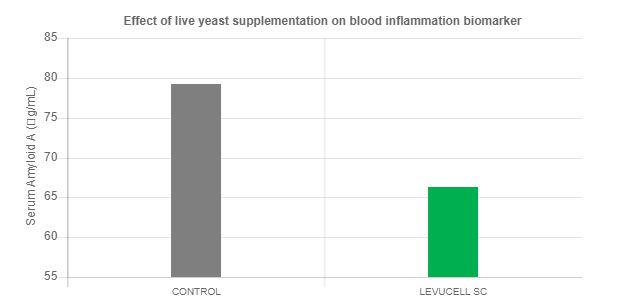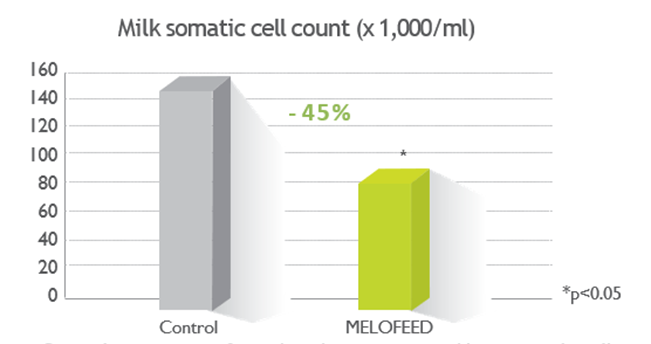Blog | Reading Time 8 minutes
Heat stress can disturb dairy cows postpartum, could producers find solutions through nutrition?
Heat stress can disrupt milk production, but new tools are available to help nutritionists and farmers around the world estimate their losses — and take steps to regain production. Plus, recent research investigates the link between heat stress, immune response, and inflammatory and antioxidant status of cows. It appears that, for transition cows, the situation can be even more challenging.
Heat stress: A trigger for postpartum dairy cows
Elevated temperatures trigger cortisol secretion, which is also known as the stress hormone. Scientists have shown that heat stress can affect the cow’s innate immunity, disrupt inflammatory patterns and affect her antioxidant capacity (Li et al., 2021). Research has shown that increases in the temperature and humidity index (THI) increase the incidence of uterine diseases and retained placentas (Gernand et al., 2019). Uterine diseases already affect up to 40% of postpartum cows. Other studies show that milk somatic cell counts (SCC) increase as the THI increases, as well as the number of milk samples with bacterial contamination.
This can mean that the host’s resistance or ability to fight against pathogens is reduced when the cow reaches the maximum of its temperature comfort zone, which can start at 18°C, depending on humidity, and corresponds to a THI of around 68.
Heat stress decreases milk production
In a recent study (Molinari et al., 2022), heat-stressed cows showed a decrease in milk production (35.8 to 31.9 kg/d), consistent with previous findings (Collier et al., 2017). They are also more likely to have increased inflammatory responses in the postpartum period compared to cows not submitted to heat stress. Same findings were shown by Menta. et al., 2022. Reduced milk yield is also associated with heat stress, whether the hot period occurs before parturition, after parturition, or both.
Milk yield reduction is observed both in heifers and multiparous cows with a reduction of milk yield from 1.7kg milk/cow/day to 2.4kg milk/cow/day during the first 90 days postpartum. The consequences of heat stress seem to be almost the same when cows were exposed to hot periods before or after calving or during the whole period (THI > 72).
This information shows that measures to alleviate the consequences of heat stress should be considered during the entire transition period, from dry-off to the first months into lactation.
Reduced dry matter intake may increase the risk of disease
Reduction of dry matter intake (DMI) is commonly observed during hot periods. Research shows that uterine disease is linked with reduced DMI and altered feeding behavior before calving (Hammon et al., 2006; Huzzey et al., 2007). Even more than multiparous cows, heifers have greater nutrient needs before their first calving because of extensive mammogenesis during late pregnancy- — making supporting heifer nutrition even more important. It is possible the reduction of DMI observed during heat stress affects heifers more than multiparous cows. This could explain why heifers seem more predisposed to uterine diseases (Menta et al., 2022).
Solutions for managing heat stress
It is crucial to implement practices that can help alleviate heat stress on both gestating and lactating cows.
Physically reducing the heat burden can be accomplished through barn design, shade provisions, fans, and maintaining an adequate water supply. Farm managers can also look at nutritional approaches to maintain the intake, mitigate inflammation and support the resistance of cows to oxidative stress.
Among these solutions, microbial-based solutions have proven effective in dairy cows.
- Live yeast for improved feed efficiency under stress
Studies show cows can improve their ability to extract energy from their diet with the addition of the live yeast strain Saccharomyces cerevisiae CNCM I-1077. Perdomo et al., 2020 showed improvement in feed efficiency with + 130g of milk/kg DMI in lactating dairy cows under heat stress with the addition of the specific live yeast S. cerevisiae CNCM I-1077 (LEVUCELL SC), fed at specific heat stress dosage (20×109 CFU/head/day).
The same study also showed that adding the live yeast improves rumination behavior by increasing chewing time and reducing the time between rumination bouts. S. cerevisiae CNCM I-1077, fed at a specific heat stress dosage (20×109 CFU/head/day), improves ruminating activity (Figure 1), in addition to reducing signs of inflammation with less inflammatory compounds found in blood (Figure 2), which confirmed findings in earlier studies in transition cows (Bach et al., 2018, Bach et al., 2019).
Figure 1: Effect of live yeast supplementation on the average interval between rumination bouts under heat stress (From Perdomo at el., 2020).

Figure 2: Effect of live yeast supplementation on blood inflammation biomarker (from Perdomo at el., 2020).
- Maintaining the antioxidative balance
Maintaining a balanced antioxidant status is one way to support an enhanced immune system and alleviate the negative post-partum consequences of heat stress such as increased inflammation and decreases in milk production.
Feeding a specific antioxidant with a high level of bioavailability such as selenium-enriched yeast (ALKOSEL), and a supplement rich in superoxide dismutase (SOD) (MELOFEED) (Fig. 3 & 4) under high heat stress environment, was shown to:
- Improve antioxidant capacity around parturition (Niwinska and Andrejewski, 2017; Lallemand Animal Nutrition internal data, 2020),
- Lower somatic cell counts (Weiss and Hogan, 2005; Lallemand Animal Nutrition internal data, 2012-2013; 2020,).
Selenium supplementation is also linked to a reduction in placenta retention (Harrison et al, 2021).

Figure 3: Effect of MELOFEED supplementation on cows total antioxidant status around calving (Lallemand Animal Nutrition internal data. 2020. Commercial farm, Germany 2020)

Figure 4: Effect of MELOFEED supplementation on milk somatic cell count during heat stress period (Lallemand Animal Nutrition internal data. 2020. Commercial farm, Germany 2020)
Lallemand Animal Nutrition provides a complete range of microbial natural solutions.
Depending on your situation, experts will propose a specific program. Discover our Heat Stress program page!
REFERENCES
Bach A., Guasch I., Elcoso G., Chaucheyras-Durand F., Castex M., Fàbregas F., Garcia-Fruitos E., and Aris A. , 2018. Changes in gene expression in the rumen and colon epithelia during the dry period through lactation of dairy cows and effects of live yeast supplementation. J Dairy Sci. 101(3):2631–2640
Bach A., Lopez-Garcia A., Gonzalez-Recio O., Elcoso G., Fabregas F,. Chaucheyras-Durand F., Castex M., 2019. Changes in the rumen and colon microbiota and effects of live yeast dietary supplementation during the transition from the dry period to lactation of dairy cows. J Dairy Sci. 102( 7):6180-6198
Collier, R. J., R. B. Zimbelman, R. P. Rhoads, M. L. Rhoads, and L. H. Baumgard. 2017. A re-evaluation of the impact of temperature humidity index (THI) and black globe humidity index (BGHI) on milk production in high producing dairy cows. :113–125 in Proc. Western Dairy Management Conference, Reno, NV.
Gernand, E., Konig S., and Kipp C.. 2019. Influence of on-farm measurements for heat stress indicators on dairy cow productivity, female fertility, and health. J. Dairy Sci. 102:6660–6671.
Hammon, D., Evjen, I. M., Dhiman, T. R., Goff, J. P., & Walters, J. L. 2006. Neutrophil function and energy status in Holstein cows with uterine health disorders. Veterinary immunology and immunopathology, 113(1-2), 21-29.
Huzzey, J. M., Veira, D. M., Weary, D. M., & Von Keyserlingk, M. A. G. 2007. Prepartum behavior and dry matter intake identify dairy cows at risk for metritis. Journal of dairy science, 90(7), 3220-3233.
Li, H., Y. Zhang, R. Li, Y. Wu, D. Zhang, H. Xu, Y. Zhang, and Z. Qi. 2021. Effect of seasonal thermal stress on oxidative status, immune response and stress hormones of lactating dairy cows. Anim. Nutr. 7:216–223.
Menta, P. R., Machado, V. S., Piñeiro, J. M., Thatcher, W. W., Santos, J. E. P., & Vieira-Neto, A. 2022. Heat stress during the transition period is associated with impaired production, reproduction, and survival in dairy cows. Journal of Dairy Science, 105(5), 4474-4489.
Molinari, P. C., Davidson, B. D., Laporta, J., Dahl, G. E., Sheldon, I. M., & Bromfield, J. J. 2023. Prepartum heat stress in dairy cows increases postpartum inflammatory responses in blood of lactating dairy cows. Journal of Dairy Science, 106(2), 1464-1474.
Niwinska, B., M., Andrzejewski. 2017. The effects of forms of selenium in supplement on the diet–cow–calf transfer of selenium in Simmental cattle. Czech Journal of Animal Science, 62(5):201-210
Perdomo, M. C., Marsola, R. S., Favoreto, M. G., Adesogan, A., Staples, C. R., & Santos, J. E. P. 2020. Effects of feeding live yeast at 2 dosages on performance and feeding behavior of dairy cows under heat stress. Journal of Dairy Science, 103(1), 325-339.
Weiss, W. P., J. S. Hogan. 2005. Effect of Selenium Source on Selenium Status, Neutrophil Function, and Response to Intramammary Endotoxin Challenge of Dairy Cows. Journal of Dairy Science, 88:4366–4374
Published Apr 6, 2023 | Updated Jun 7, 2023
Related articles
Need specific information?
Talk to an expert